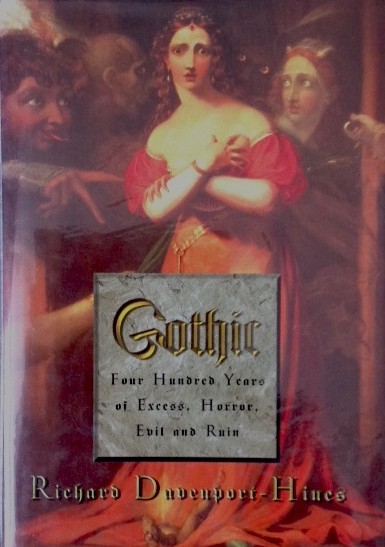Inspiring Older Readers
 posted on 21 Jul 2022
posted on 21 Jul 2022
Gothic by Richard Davenport-Hines
This overview of all things Gothic by Richard Davenport-Hines starts from quite a simple proposition – the Gothic exists because it captures humanity’s need for flirting with the dark side. The sub-title of the book captures the frisson of illicit pleasure the Gothic can suggest - Four Hundred Years of Excess, Horror, Evil and Ruin – and who would want to resist such an invitation?
So how did we arrive at our modern day ideas of what constitutes the Gothic? Well, Davenport-Hines takes us by the hand and leads us along a winding road that ends with the likes of Hammer Horror, Goth music and writers like Poppy Z. Brite – about whom Davenport-Hines seems to have something of an obsession. The journey starts with, what for me, is the most pedestrian part of the book – the way the natural world is not always Arcadian but capable of promoting a sense of sublime terror.
The dread that nature is able to promote in humanity is also reflected in the buildings they erected – crenelated towers with dark corners and over-elaborate decoration that inspired many an artists to see them as places of mystery and potential dark doings.
Soon we are awash in the lives and works of artists, poets, novelists who collectively define the culture of the Gothic - de Sade, Goya, Piranesi, Fuseli, Mary Shelley, Poe, Stoker and Stevenson. And, I think the author’s ambition to be as comprehensive as possible begins to weigh the study down as we start to get a bit too much of the marginal cul-de-sacs that branch off from the main road of the story of the Gothic.
It wasn’t too long before I felt that this was something of a worthy chronological trek when the potential was there for something a bit more thrilling. Michael Dirda reviewing the book for The Washington Post also noted the way the book took a somewhat plain route rather than one calculated to thrill:
“shouldn't a book about "excess, horror, evil and ruin" be a little more provocative, even a bit . . . slutty? Shouldn't it titillate, horrify, seduce and disorient? Certainly, Davenport-Hines's subtitle would suggest such 3-D effects, but only in the last chapters – on contemporary horror writer Poppy Z. Brite, filmmaker David Lynch, singer-songwriter Robert Smith of the Cure, and artists such as the Chapman brothers – does one feel the quickened rush of authorial excitement.”
In the end I’m not really sure what the underlying philosophical ideas are that Davenport-Hines uses to include or exclude artists and writers from being given the title of ‘Gothic’ – it’s not just that he includes people you’d hardly expect but also who he chooses to put under the microscope. What on earth is Alexander Pope doing in a study of the Gothic? And I really didn’t need to have so much detail about the painter, Salvator Rosa.
Ultimately, the book ends up feeling like a reference book rather than a good read and that seems to be underscored by the format of the hardback which is the size and weight of a brick – it is printed on beautiful art paper that provides a high quality surface for the reproduction of images but makes it a heavy book to read casually.
Paperback editions can be found but, like the hardback, are quite expensive. It’s not entirely clear whether the book is still in print but if you’re looking for a copy it would probably be best to try the usual second-hand sites.
Terry Potter
July 2022